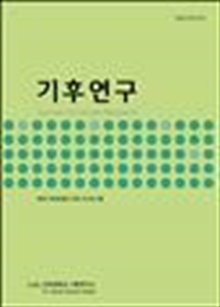간행물
기후연구 KCI 등재 Journal of Climate Research

- 발행기관 건국대학교 기후연구소
- 자료유형 학술지
- 간기 계간
- ISSN 1975-6151 (Print)2288-8772 (Online)
- 수록기간 2006 ~ 2021
- 주제분류 사회과학 > 지리학 사회과학 분류의 다른 간행물
- 십진분류KDC 453DDC 551
권호리스트/논문검색
제12권 제3호 (2017년 9월) 4건
1.
2017.09
서비스 종료(열람 제한)
This study aims to investigate the characteristics of the disaster by heavy snowfall in South Korea based on the disaster yearbooks published from 1979 to 2014. We analyses the spatial distributions and temporal changes of disaster caused by heavy snowfall as well as the damage related to the snow depth. According to the change in the property loss by heavy snowfall and the snow depth, there was no major damage by heavy snowfall in 1980~1999 when the new snowfall tended to decrease by -1.4 cm/year. However, the fluctuation in the sum of new snowfall in the 2000s was also the most unstable, resulting in heavy damage by heavy snowfall. The sensitivity on the snow depth is different depending on the geographical regions, but the property loss by heavy snowfall increases as the sum of new snowfall and the maximum snow depth increase.
2.
2017.09
서비스 종료(열람 제한)
The purpose of this study is to quantify the magnitudes of projected 21st century temperature changes and shifting climate zones over Mt. Halla, Korea based on high-resolution (1km×1km) climate change scenario data sets down-scaled from a global climate model (HadGEM2-AO) simulations using PRIDE (PRISM based Downscaling Estimation Model) as well as the simulations of a Regional Climate Model (RCM; HadGEM3-RA). The high resolution climate data demonstrate that the magnitudes of increases in coldest and warmest monthly mean temperatures over Mt. Halla will exceed those of the averages across the Korean Peninsula during the 21st century, leading to the shifts of climate zones. The isoline with 5°C (20°C) of the coldest (warmest) monthly average temperature associated with sub-tropical (sub-alpine) climate zones will migrate from 100~230m (950~1,300m) to 300~500m (1,300~1,600m) of altitude in the late 21st century (2071~2100) under the RCP 4.5 scenario. These changes are expected to be more obviously observed in the south flank of Mt. Halla as well as under the RCP 8.5 scenario. These results indicate that changes in climate zones will lead to the extinction of sub-alpine ecosystems over Mt. Halla due to increases of summertime heat stress as well as to the expansion of the sub-tropical forest zone toward mid-mountain regions due to reduction of wintertime stress in the warmer 21st century.
3.
2017.09
서비스 종료(열람 제한)
This study examined the regime shifts in the temperature difference between Daegu and Jeju for the month of August using a Markov regime switching model. Using the long-term time series of averaged monthly temperature in August for 1923- 2015, we found the two regimes in the temperature difference with the regime shift taking place in 1952. The first regime, which spans the period from 1923 to 1951, is identified as Daegu, on average, being 0.2°C hotter than Jeju. The second regime, which starts in 1952 and persists until 2015, is characterized as the average temperature of Jeju being 0.4°C higher than that of Daegu. The results are consistent with a regime shift in the temperature of Jeju itself from a low temperature regime to a high temperature regime.
4.
2017.09
서비스 종료(열람 제한)
In this paper, we used a nonhomogeneous Gaussian regression model (NGR) as the postprocessing techniques to calibrate probabilistic forecasts that take the form of probability density functions for temperature. We also performed the alternative implementation techniques of NGR, which are stationspecific ensemble model output statistics (EMOS) model. These techniques were applied to forecast temperature over Pyeongchang area using 24-member Ensemble Prediction System for Global (EPSG). The results showed that the station-specific EMOS model performed better than the raw ensemble and EMOS model.

